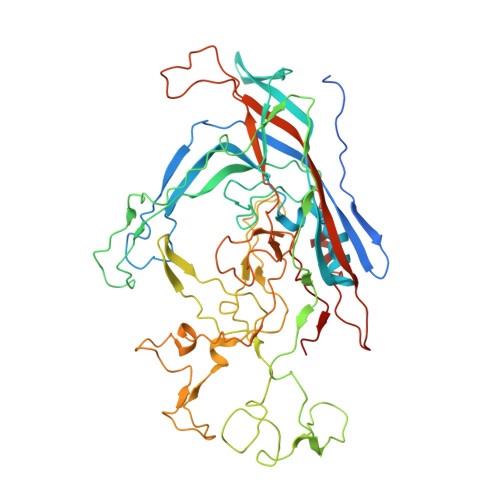Examination and Reconstruction of Three Ancient Endogenous Parvovirus Capsid Protein Gene Remnants Found in Rodent Genomes.
Callaway, H.M., Subramanian, S., Urbina, C.A., Barnard, K.N., Dick, R.A., Bator, C.M., Hafenstein, S.L., Gifford, R.J., Parrish, C.R.(2019) J Virol 93
- PubMed: 30626673
- DOI: https://doi.org/10.1128/JVI.01542-18
- Primary Citation of Related Structures:
6NF9 - PubMed Abstract:
Parvovirus-derived endogenous viral elements (EVEs) have been found in the genomes of many different animal species, resulting from integration events that may have occurred from more than 50 million years ago to much more recently. Here, we further investigate the properties of autonomous parvovirus EVEs and describe their relationships to contemporary viruses. While we did not find any intact capsid protein open reading frames in the integrated viral sequences, we examined three EVEs that were repaired to form full-length sequences with relatively few changes. These sequences were found in the genomes of Rattus norvegicus (brown rat), Mus spretus (Algerian mouse), and Apodemus sylvaticus (wood mouse). The R. norvegicus sequence was not present in the genomes of the closely related species R. rattus , R. tanezumi , R. exulans , and R. everetti , indicating that it was less than 2 million years old, and the M. spretus and A. sylvaticus sequences were not found in the published genomes of other mouse species, also indicating relatively recent insertions. The M. spretus VP2 sequence assembled into capsids, which had high thermal stability, bound the sialic acid N -acetylneuraminic acid, and entered murine L cells. The 3.89-Å structure of the M. spretus virus-like particles (VLPs), determined using cryo-electron microscopy, showed similarities to rodent and porcine parvovirus capsids. The repaired VP2 sequences from R. norvegicus and A. sylvaticus did not assemble as first prepared, but chimeras combining capsid surface loops from R. norvegicus with canine parvovirus assembled, allowing some of that capsid's structures and functions to be examined. IMPORTANCE Parvovirus endogenous viral elements (EVEs) that have been incorporated into the genomes of different animals represent remnants of the DNA sequences of ancient viruses that infected the ancestors of those animals millions of years ago, but we know little about their properties or how they differ from currently circulating parvoviruses. By expressing the capsid proteins of different parvovirus EVEs that were found integrated into the genomes of three different rodents, we can examine their structures and functions. A VP2 (major capsid protein) EVE sequence from a mouse genome assembled into capsids that had a similar structure and biophysical properties to extant parvoviruses and also bound sialic acids and entered rodent cells. Chimeras formed from combinations of canine parvovirus and portions of the parvovirus sequences from the brown rat genome allowed us to examine the structures and functions of the surface loops of that EVE capsid.
- Baker Institute for Animal Health, Department of Microbiology and Immunology, College of Veterinary Medicine, Cornell University, Ithaca, New York, USA.
Organizational Affiliation:
















